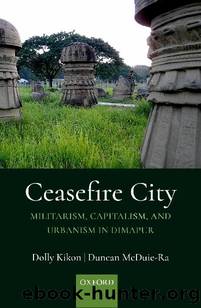Ceasefire City by Dolly Kikon & Duncan McDuie-Ra

Author:Dolly Kikon & Duncan McDuie-Ra [Kikon, Dolly & McDuie-Ra, Duncan]
Language: eng
Format: epub
Publisher: OUP India
Published: 2020-11-29T00:00:00+00:00
Image 3.3 Alobo Naga at Musik-A
Source: Duncan McDuie-Ra
âI am starting a busking culture in Dimapur. Here, right outside the music school. We will not get any money initially but they [students] must learn how to play on the street,â Alobo said.4 In Dimapur, the highway AH1 is also a city âstreetâ and an integral part of the city. Localities, shops, commercial ventures, and schools have come up along this highway. Alobo joins thousands of commuters every day in navigating through the crowded cars and trucks along the AH1, crossing localities, shops, and schools to arrive at his music school. Such experiences, ranging from organizing busking shows along AH1 and moving in crowded highways cutting across the city, highlight the dimensions of mobilities and spatial realities in frontier regions. By 2018, the highway construction project had expanded right to the doorstep of the music school, taking away any pedestrian space to busk, or even walk. The semi-completed road expansion churned out dust and fumes, making re-purposing by musicians impossible.
While residents of Dimapur often talked about the crumbling infrastructure of the city, musicians and performers connected with everyday challenges that were not limited to power failures, load shedding, and unemployment, but also with experiences of finding love and/or encountering heartache in the city. And then there is always a grim reminder that hovers over this vast and growing cityscape: the presence of two ceasefire camps in the peri-urban areas of the city where warring factions of Naga armed groups wait for a final political solution. As political negotiations continue, the fragile political reality comes to the forefront. As such, the city is not an easy place to navigate.
Since musicians like Alobo Naga sing and perform and connect with a home crowd, they are able to find a home across the city and beyond. Aloboâs lyrics not only highlight the experiences and aspirations for peace and dignity, but they also invoke familiar landscapes of and dwellings in the city. Irrespective of the difficulties and challenges of living in Dimapur, people always find ways to celebrate the city. In 2016, Morung Express, a local English daily from the city, carried the reflections of a young college student. In an essay titled âDimapurâHeaven or Hell?â, Tsukhumla Yimchunger gave an account of things in the city that were broken. The state of disrepair in Dimapur, according to Yimchunger (2016), mirrored âhellâ on earth. In other words, Dimapur was urban hell on earth. However, the tone of the essay shifted once she began to list out the beauty of the city. From green parks in the outskirts of the city to the exciting Christmas celebrations, she described the fun of living in Dimapur and concluded her essay with an appeal that read, âDimapur is our home, and maybe itâs time we all work together to create it into an ideal city, a city we would be proud to live in, a city which we would pass down to our future generations with much prideâ (Yimchunger 2016).
As discussed
Download
This site does not store any files on its server. We only index and link to content provided by other sites. Please contact the content providers to delete copyright contents if any and email us, we'll remove relevant links or contents immediately.
Cecilia; Or, Memoirs of an Heiress — Volume 1 by Fanny Burney(32062)
Cecilia; Or, Memoirs of an Heiress — Volume 3 by Fanny Burney(31458)
Cecilia; Or, Memoirs of an Heiress — Volume 2 by Fanny Burney(31409)
The Great Music City by Andrea Baker(30781)
We're Going to Need More Wine by Gabrielle Union(18633)
All the Missing Girls by Megan Miranda(14736)
Pimp by Iceberg Slim(13779)
Bombshells: Glamour Girls of a Lifetime by Sullivan Steve(13685)
Fifty Shades Freed by E L James(12915)
Talking to Strangers by Malcolm Gladwell(12875)
Norse Mythology by Gaiman Neil(12828)
For the Love of Europe by Rick Steves(11473)
Crazy Rich Asians by Kevin Kwan(8888)
Mindhunter: Inside the FBI's Elite Serial Crime Unit by John E. Douglas & Mark Olshaker(8702)
The Lost Art of Listening by Michael P. Nichols(7160)
Enlightenment Now: The Case for Reason, Science, Humanism, and Progress by Steven Pinker(6874)
The Four Agreements by Don Miguel Ruiz(6319)
Bad Blood by John Carreyrou(6277)
Weapons of Math Destruction by Cathy O'Neil(5832)
